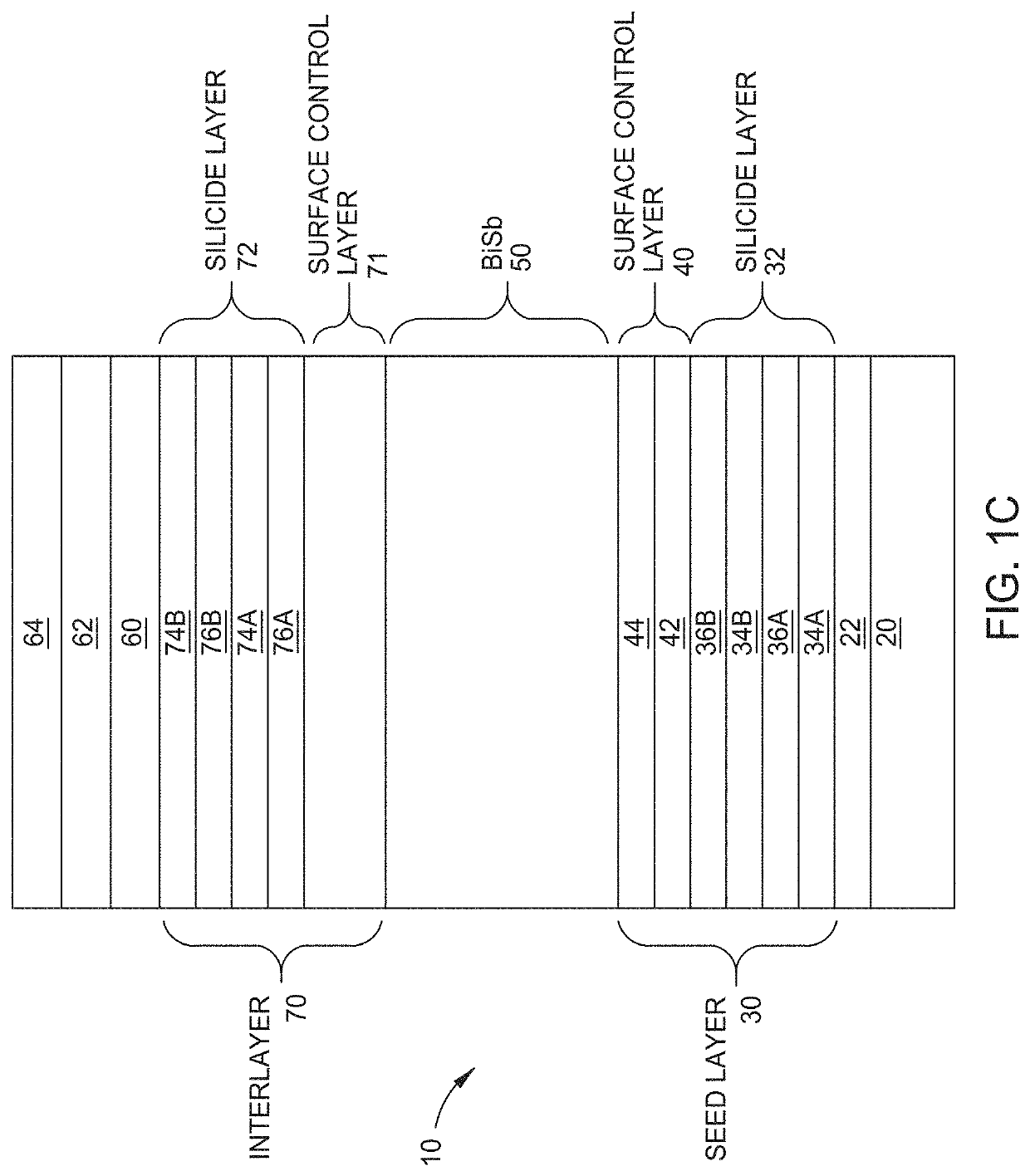BiSb Topological Insulator with Seed Layer or Interlayer to Prevent Sb Diffusion and Promote BiSb (012) Orientation
- Summary
- Abstract
- Description
- Claims
- Application Information
AI Technical Summary
Benefits of technology
Problems solved by technology
Method used
Image
Examples
examples
[0076]The following are examples to illustrate various embodiments of a BiSb layer, such as the BiSb layer 50 of FIGS. 1A-1E, the magnetic drive 100 of FIG. 3, the write head 210 of FIG. 3, the SOT MTJ devices 230 of FIGS. 4 and 5, other BiSb layers, other magnetic drives, other SOT MTJ devices, and variations thereof. These examples are not meant to limit the scope of the claims unless specifically recited in the claims.
example a
[0077]In Example A, a sample was formed by physical vapor deposition (PVD) of a base layer of non-conductive amorphous silicon to a thickness of about 18 Å. A single composition graded silicide layer was formed by PVD on the base layer of a laminate Si / NiFe stack with the approximate thicknesses of Si 4 Å, NiFe 2 Å, Si 4 Å, NiFe 2 Å, Si 4 Å, and NiFe 5 Å. A surface control layer of Cu was formed by PVD on the NiFe 5 Å layer to a thickness of about 5 Å silicide layer deposited by PVD. The surface control layer was made of Cu 5 Å. A BiSb layer was formed by PVD on the Cu layer to a thickness of about 100 Å. X-ray diffraction (XRD) 2Θ scans of the sample was conducted as shown in FIG. 6. The BiSb layer showed (012) orientation with a low or no amount of (003) orientation.
example b
[0078]In Example B, sample 710 was formed by PVD of a laminate stack with the approximate thicknesses of Si 14 Å and a NiFe 7 Å. The laminate stack formed a high-resistance, single-composition, graded, silicide layer after room temperature intermixing. A surface control layer of Cu was formed by PVD on the silicide layer to a thickness of about 5 Å. A BiSb layer was formed by PVD on the surface control layer to a thickness of about 100 Å. An interlayer of a laminate stack with the approximate thicknesses of Si 10 Å, NiFe 5 Å, Si 10 Å, and NiFe 5 Å was formed by PVD on the BiSb layer. The interlayer laminate stack formed a high-resistance, single-composition, graded, silicide layer after room temperature intermixing.
[0079]Sample 720 was formed by PVD of a seed layer of a laminate stack with the approximate thickness of Si 16 Å and a NiFe 7 Å. The seed layer laminate stack formed a high-resistance, single-composition, graded, silicide layer after room temperature intermixing. A surfac...
PUM
 Login to View More
Login to View More Abstract
Description
Claims
Application Information
 Login to View More
Login to View More - R&D
- Intellectual Property
- Life Sciences
- Materials
- Tech Scout
- Unparalleled Data Quality
- Higher Quality Content
- 60% Fewer Hallucinations
Browse by: Latest US Patents, China's latest patents, Technical Efficacy Thesaurus, Application Domain, Technology Topic, Popular Technical Reports.
© 2025 PatSnap. All rights reserved.Legal|Privacy policy|Modern Slavery Act Transparency Statement|Sitemap|About US| Contact US: help@patsnap.com



